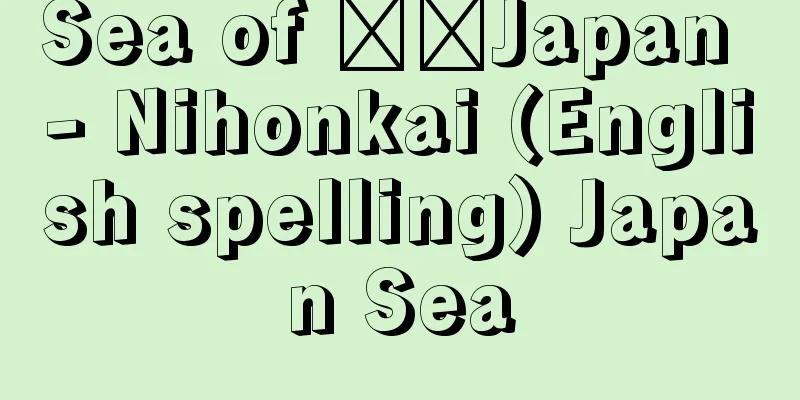Sea of Japan - Nihonkai (English spelling) Japan Sea

|
It is one of the marginal seas of the North Pacific Ocean, located between the Japanese archipelago and the Asian continent. It has an area of 1,008,000 square kilometers, an average depth of 1,350 meters, a maximum depth of 3,796 meters, and a volume of 1,361,000 cubic kilometers, of which the continental shelf shallower than 200 meters is 280,000 square kilometers, and the deep sea basin deeper than 3,000 meters is 300,000 square kilometers. The seafloor topography is relatively shallow north of 44 degrees north latitude, and deep sea basins dominate in the central area (44-40 degrees north latitude). The seafloor topography in the southwestern part is complex and undulating, with four banks stretching from north to south, one of which, Yamato Bank (236 meters shallowest part), can be seen at the northern end. The geographical shape of the Sea of Japan became clear after La Pérouse's exploration in 1787 and Mamiya Rinzo's survey of Karafuto (Sakhalin) in 1808-1809 (Bunka 5-6), and the name Sea of Japan was first used on a nautical chart by Russian navigator Krusenstern in 1815. Oceanographic surveys of the Sea of Japan began with the Russian Admiral Makarov's ship Vichardy conducted in 1886-1889, followed by surveys using ocean current bottles by Wada Yuji in 1913-1917 (Taisho 2-6), and then surveys by survey ships such as Yamato (Navy), Soyo Maru (Fisheries Research Station), and Shunpu Maru (Kobe Marine Meteorological Observatory) from the 1920s to the 1940s. Currently, regular monthly and seasonal oceanographic observations are continued by the Fisheries Research Station, Maizuru Marine Meteorological Observatory, and other vessels. In addition, from 1993 to 2002, a comprehensive study of the Sea of Japan, called "Circulation Research of the East Asian Marginal Seas (CREAMS)," was conducted as a joint research project between Japan, South Korea, and Russia, using the latest observation methods (artificial satellites, mid-depth floats, etc.). In addition, Korea claims that the Sea of Japan has been called the "East Sea" since ancient times, and there are efforts by South Korea and other countries to change the name of the Sea of Japan to the "East Sea." In response, the Japanese government claims that the name "Sea of Japan" is internationally established both geographically and historically, and is lobbying South Korea to justify Japan's claim. [Kouichi Nagasaka and Koichi Ishikawa] Sea conditionsThe two main currents in the Sea of Japan are the Tsushima Current (Warm Tsushima Current), which flows in through the Tsushima Strait and exits into the Tsugaru and Soya Straits, and the Liman Current (Cold Current), which flows south off the coast of Primorsky Krai, Russia. The sea surface temperature is 25-26°C from the Tsushima Strait to the coast of Honshu in summer, around 20°C off the coast of Primorsky Krai, 12-13°C near the Tsushima Strait in winter, and below 0°C along the northern coast of Primorsky Krai, with freezing observed in some areas from mid-November to April. In the northern part of the Sea of Japan, the area below the thermocline, about 500 meters below the sea surface, is occupied by homogeneous water called the Sea of Japan proper water (water temperature below 1°C, salinity 34.0-34.1 psu, psu is a practical salinity unit), which has cooled at the sea surface in winter and sunk down. In the 1990s, high-precision observations became possible, and the Japan Sea proper water was vertically divided into several water masses. The Sea of Japan plays a role in warming Japan's climate in the winter. As northwesterly seasonal winds blow over the Sea of Japan, they replenish a great deal of heat and water vapor from the sea surface, bringing snowfall to the Sea of Japan side of Honshu. Due to the seasonal winds, more than 90% of days in winter are stormy, and from spring to early summer, sea fog is often seen, especially in the cold current areas in the north. In addition, the influence of ocean currents and prevailing winds causes various drifting objects to be washed up on the coast of Honshu from the continent. There are many areas where cold-current fish species such as salmon, trout, and cod and warm-current fish species such as sardines and mackerel coexist, and the southern and northern limits of both species are wider north and south than in the North Pacific Ocean. [Kouichi Nagasaka and Koichi Ishikawa] "Horikoshi Masuoki, Nagata Yutaka, Sato Tatsuhiro, "Japan's Nature 7: The Seas Surrounding the Japanese Archipelago" (1987, Iwanami Shoten)" ▽ "Hoshino Michihira, Kubota Tadashi, eds., "Japan's Nature 3: The Seas of Japan" (1987, Heibonsha)" ▽ "Nishimura Saburo, "The Establishment of the Sea of Japan - An Approach from Biogeography," revised edition (1990, Tsukiji Shokan)" ▽ "Fujioka Kantaro, "The Science of the Deep Seabed - Diving the Japanese Archipelago" (1997, Japan Broadcasting Publishing Association)" ▽ "Toyama Studies Research Group, eds., "New Trends around the Sea of Japan" (1999, Kita Nippon Shimbun)" ▽ "Japan Sea Studies Promotion Council, eds., "A New Century of Japan Sea Studies" (2001, Toyama Prefecture Japan Sea Policy Division, Kadokawa Shoten)" ▽ "Kurazawa Eiichi, "Encyclopedia of Japan's Seas" (2001, TBS Britannica)" ▽ "Aoyagi Masanori and Ronald Tobi (eds.), "New Century of Japan Sea Studies 2: Returning Culture and Beauty" (2002, Asuka Kikaku, Kadokawa Shoten)" "Koizumi Itaru (ed.), "New Century of Japan Sea Studies 3: Circulating Sea and Forest" (2003, Asuka Kikaku, Kadokawa Shoten)" [References] | | | | |Ocean | | | | | | | | | | | | | | | | |©Shogakukan "> Bathymetric map of the Sea of Japan Source: Shogakukan Encyclopedia Nipponica About Encyclopedia Nipponica Information | Legend |
|
日本列島とアジア大陸の間に位置する北太平洋の縁海の一つ。面積100万8000平方キロメートル、平均水深1350メートル、最大水深3796メートル、容積136万1000立方キロメートルで、このうち200メートル以浅の大陸棚は28万平方キロメートル、3000メートル以深の深海盆は30万平方キロメートルである。海底地形は、北緯44度以北では比較的浅く、中央部(北緯44~40度)では深海盆が多くを占めている。南西部の海底地形は複雑に起伏し、四つの堆(たい)が南北に延び、その一つの北端には大和堆(やまとたい)(最浅部236メートル)がみられる。 日本海の地理的形状が明らかになったのは、1787年のラ・ペルーズの探検と1808~1809年(文化5~6)の間宮林蔵(まみやりんぞう)の樺太(からふと)(サハリン)調査以降であり、1815年にロシアの航海者クルゼンシュテルンによる海図に初めて日本海の名称が用いられた。日本海の海洋学的調査は1886~1889年に行われたロシアの提督マカロフによるビチャージ号に端を発し、1913~1917年(大正2~6)の和田雄治の海流瓶による調査に続き、その後1920年代から1940年代にかけて測量船大和(海軍)、蒼鷹(そうよう)丸(水産試験場)、春風丸(神戸海洋気象台)などによる調査が行われた。現在は水産試験場や舞鶴(まいづる)海洋気象台などにより、毎月および季節ごとの定期的な海洋観測が続けられている。また、1993(平成5)~2002年に日本、韓国、ロシアの共同研究としての総合的な日本海の研究「東アジア縁辺海の水と物質循環の研究Circulation Research of the East Asian Marginal Seas(CREAMS)」が、最新の観測手法(人工衛星、中層フロートなど)を使って行われた。 なお、朝鮮では古くから日本海のことを「東海」といったと主張し、日本海の呼称を東海に変更しようとする働きかけが韓国等により行われている。これに対して、日本政府は「日本海」の呼称は地理的にも、歴史的にも国際的に定着していると主張しており、日本の主張の正当性を韓国に働きかけている。 [長坂昂一・石川孝一] 海況日本海の海流は、対馬(つしま)海峡から流入し津軽、宗谷(そうや)両海峡に抜ける対馬海流(対馬暖流)と、ロシアの沿海地方沖を南下するリマン海流(寒流)の二つが主要なものである。海面水温は、夏季には対馬海峡から本州沿岸沿いで25~26℃、沿海地方沖で20℃前後、冬季には対馬海峡付近で12~13℃、沿海地方北部沿岸では0℃以下となり、11月中ごろから4月にかけては一部で結氷現象がみられる。また水温躍層の下の海面下約500メートル以深は、日本海の北部で、冬季に海面で冷却され沈降してきた日本海固有水とよばれる均質な水(水温1℃以下、塩分濃度34.0~34.1psu。psuは実用塩分単位)が占めている。また1990年代になって、高精度な観測が可能となり、日本海固有水は鉛直的にいくつかの水塊に分類されている。 日本海は、冬季の日本の気候を温暖にする役割を果たしている。北西の季節風が日本海上空を吹く間に海面から多大の熱と水蒸気を補給され、本州の日本海側に降雪をもたらしている。季節風に伴い、冬季には時化(しけ)の日が9割以上を占め、春から初夏にかけては北部の寒流域を中心に海霧の発生をみることが多い。また海流と卓越風の影響で、大陸側から種々の漂流物が本州沿岸に寄せられている。 サケ、マス、タラなどの寒流系、マイワシ、サバなどの暖流系の魚種が混在する海域が多く、両者の南限および北限は北太平洋に比較してそれぞれ南北に広がっている。 [長坂昂一・石川孝一] 『堀越増興・永田豊・佐藤任弘著『日本の自然7 日本列島をめぐる海』(1987・岩波書店)』▽『星野通平・久保田正編著『日本の自然3 日本の海』(1987・平凡社)』▽『西村三郎著『日本海の成立――生物地理学からのアプローチ』改訂版(1990・築地書館)』▽『藤岡換太郎著『深海底の科学――日本列島を潜ってみれば』(1997・日本放送出版協会)』▽『富山学研究グループ編『環日本海、その新たな潮流』(1999・北日本新聞社)』▽『日本海学推進会議編『日本海学の新世紀』(2001・富山県日本海政策課、角川書店発売)』▽『倉沢栄一著『日本の海大百科』(2001・TBSブリタニカ)』▽『青柳正規、ロナルド・トビ編『日本海学の新世紀2 還流する文化と美』(2002・飛鳥企画、角川書店発売)』▽『小泉格編『日本海学の新世紀3 循環する海と森』(2003・飛鳥企画、角川書店発売)』 [参照項目] | | | | | | | | | | | | | | | | | | | | | |©Shogakukan"> 日本海の海底地形図 出典 小学館 日本大百科全書(ニッポニカ)日本大百科全書(ニッポニカ)について 情報 | 凡例 |
<<: Battle of Tsushima - Nihon Kaikaisen
Recommend
Kinkel, Klaus
Born December 1936. Mettinger. German politician. ...
"Creating a New Woman" - The Creation of a New Woman
...Women who returned home after the stable perio...
James Boswell
British lawyer. Born in Scotland. Author of the m...
Cratoxylon arborescens (English spelling)
… [Mitsuru Hotta]... *Some of the terminology tha...
Neotoma albigula (English name)
…[Tadaaki Imaizumi]. … *Some of the terminology t...
Tokyo Castle (English: Dong-jing)
An earthen fortress in Ning'an County, Heilong...
Iris pallida (English spelling) Irispallida
…[Hiroshi Aramata]. … From [Iris] …[Tetsuichi Yah...
Tokaido
The name of the region or road that runs east fro...
Heimito von Doderer
Austrian novelist. Born near Vienna as the son of...
resale price maintenance policy
In addition to these basic pricing policies, ther...
Family Psychotherapy
...However, the above-mentioned concepts presente...
Artery
Arteries are blood vessels that travel from the h...
La Spezia (English spelling)
A seaport city on the Tyrrhenian Sea in Liguria, n...
SGR - SGR
《 soft gamma ray repeater 》⇒ soft gamma ray repeat...
Gall, I.
…He was the founder of the Pantomime Theatre in W...







![Yanaizu [town] - Yanaizu](/upload/images/67cd0c351b029.webp)

